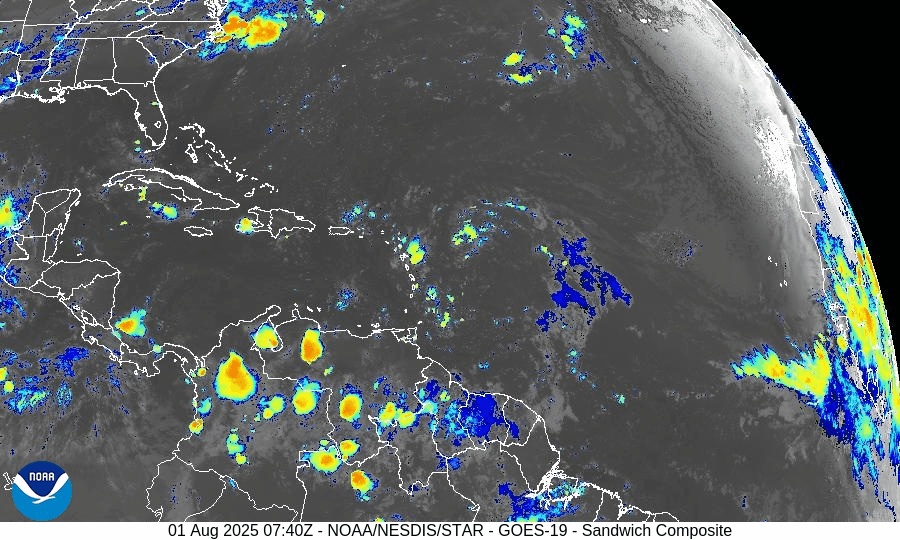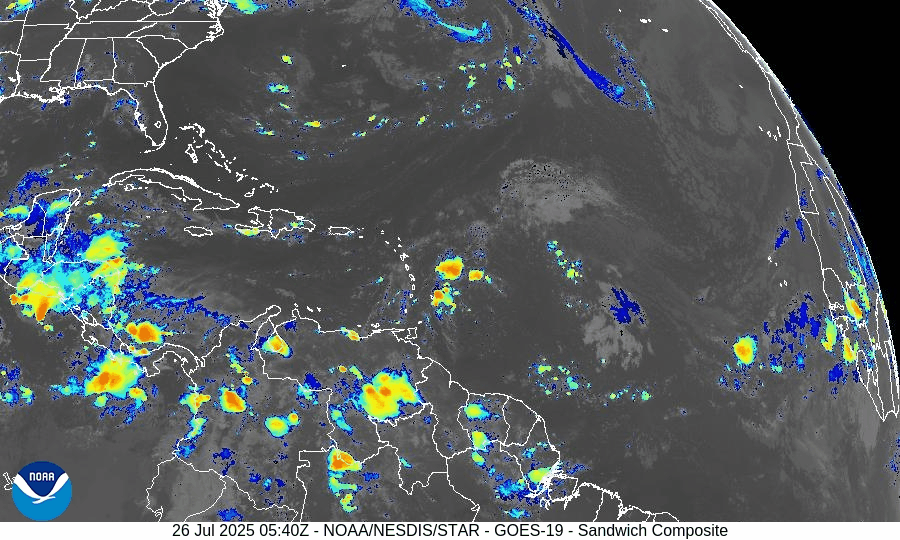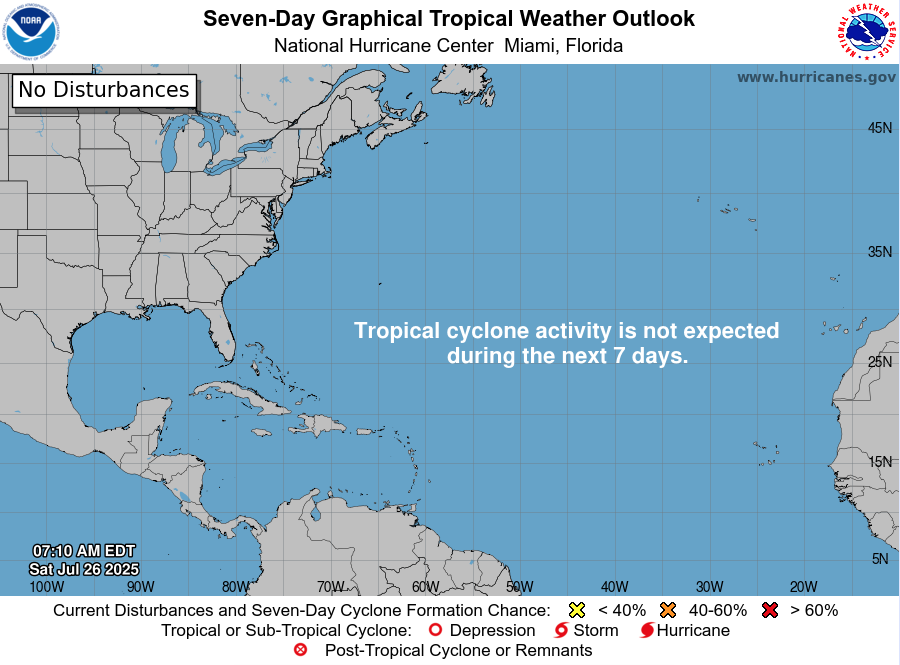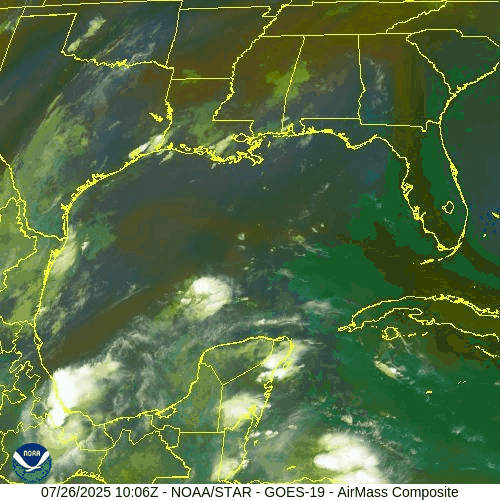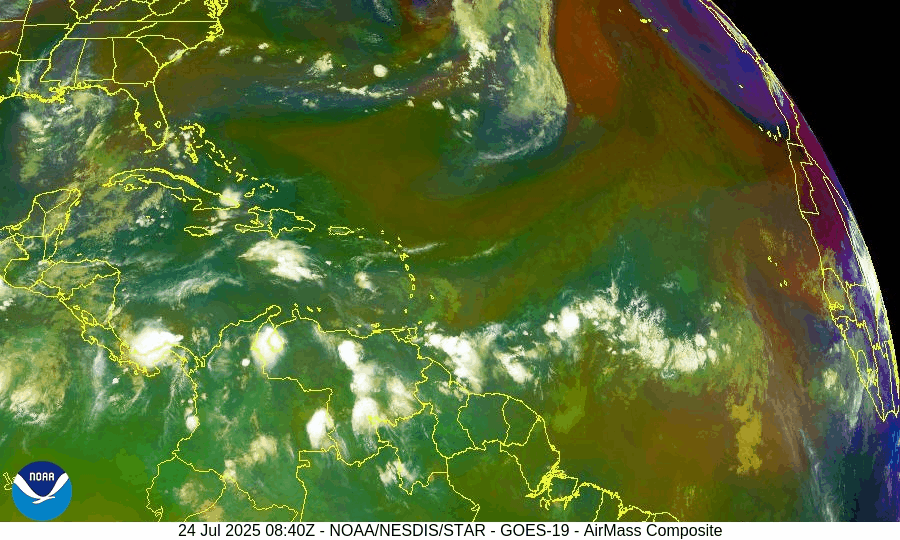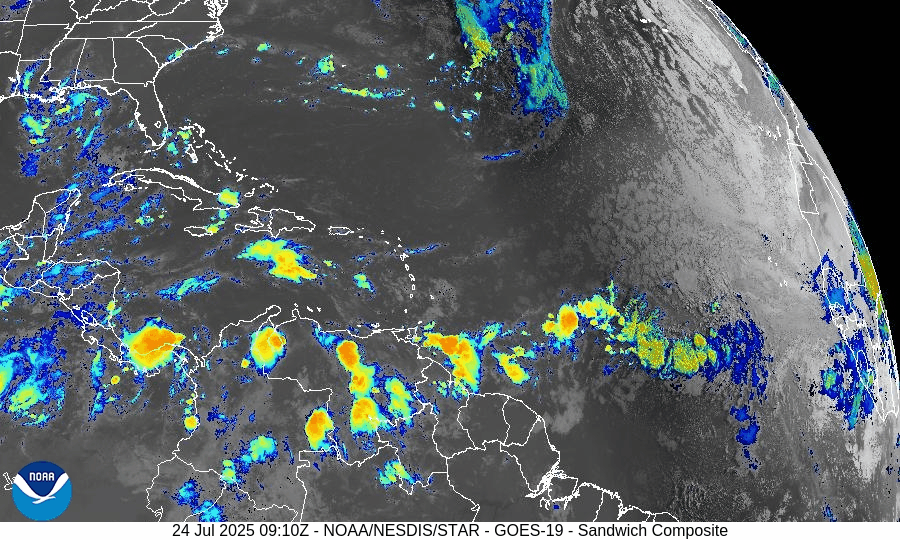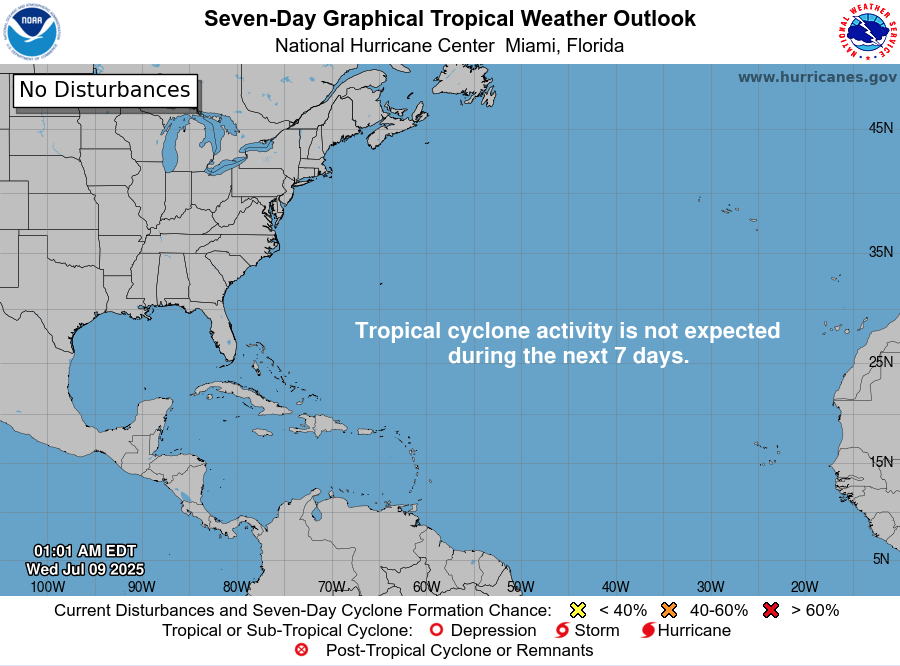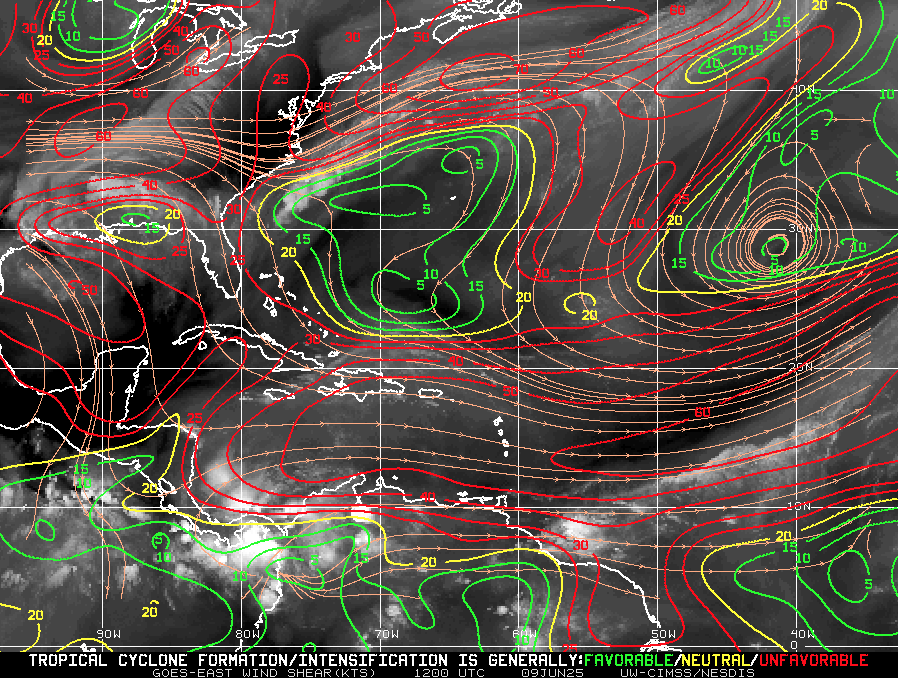Atlantic Hurricane Outlook – August 1, 2025: Quiet Tropics, Conditions Gradually Shifting
No storms expected as August begins, but multiple tropical waves are being tracked. Conditions are evolving and a shift toward higher hurricane activity is expected in the coming weeks.
*Those who like data, continue reading. Those it prefer the quick version, jump to the TL;DR here.
As we enter August—historically the onset of peak Atlantic hurricane activity—there are no active tropical cyclones and no development expected over the next seven days. However, several tropical waves are moving westward, and environmental conditions are slowly transitioning toward a more favorable pattern for storm formation later in the month.
Atlantic Basin Overview
According to the 8:00 AM EDT Tropical Weather Outlook (TWO) from the National Hurricane Center:
Tropical cyclone formation is not expected during the next 7 days WikipediaNational Hurricane Center
While no waves are currently listed as having development potential, multiple waves are traversing the eastern Atlantic.
Tropical Waves & Deep Tropics
Forecast models highlight several waves across the Atlantic, though none show organization yet:
A wave near 43–50°W, moving west at ~10–15 kt, producing scattered convection.
Another wave near 30°W, just moving off Africa, with intermittent thunderstorms.
These waves will be closely monitored as they enter warmer waters and encounter decreasing wind shear.
Environmental Conditions Snapshot
Sea Surface Temperatures (SSTs):
Gulf of Mexico & Caribbean: 29–31 °C (84–88 °F), sustaining high energy potential.
MDR: Slightly above-average values, but cooling compared to June trends .
Wind Shear:
Elevated across the Caribbean and central Atlantic—a limiting factor in early July—but gradual easing is forecast by mid-August.
Saharan Air Layer (SAL):
Persistent dry air suppressing convection across most of the MDR, but expected to weaken soon.
Atmospheric Moisture:
Enhanced moisture is slowly building in the western Atlantic, improving potential for organized convection.
Gulf of America (Mexico) & Caribbean Conditions
No disturbances are being tracked.
A dominant high-pressure ridge produces stable flow across both basins.
Offshore marine conditions remain calm, with scattered showers typical for this time of year.
Gulf of America (Mexico)
Caribbean
Florida Forecast
Highs: Low 90s °F, sticky and humid.
Precipitation: Scattered afternoon storms driven by afternoon heating and sea breeze convergence.
Winds: Light and variable inland, shifting southeast near the coast.
Rain forecast visualization courtesy of Windy.com
Prep Tip of the Day: Bookmark Tropical Outlook Sources
With activity still weeks away:
Confirm you can receive alerts from the National Hurricane Center.
Bookmark reliable sources such as Cat5Prep.com.
Ensure household members know where your hurricane documents and kits are stored.
Outlook
No cyclone formation is expected this week, but climatology and model trends suggest early-to-mid August could mark the beginning of increased tropical activity. The bulk of Atlantic season activity historically occurs after August 1, with the first hurricane typically forming around August 11.
TL;DR – August 1, 2025 Atlantic Forecast
No active or developing storms in the basin.
Several tropical waves tracked, none organized.
SSTs are warm; shear and SAL still suppressive.
A shift toward higher activity likely in early August.
Today is a good day to finalize hurricane plans and stay alert.
Atlantic Hurricane Outlook – July 27, 2025: Calm Conditions Continue Despite Active Waves
The tropics stay quiet on July 27, 2025, but tropical waves in the deep Atlantic are being closely monitored. No development is expected in the next 7 days, but changes could come as we approach August.
*Those who like data, continue reading. Those it prefer the quick version, jump to the TL;DR here.
The Atlantic basin remains free of named storms this morning, with no tropical cyclone formation expected over the next seven days. However, meteorologists are closely monitoring several tropical waves in the deep eastern Atlantic that could signal a developing pattern as we head into August.
Atlantic Basin: Quiet—but Watchful
No active tropical cyclones in the Atlantic basin.
The National Hurricane Center (NHC) reports that no tropical development is expected over the next 7 days.
Tropical waves in the eastern and central Atlantic continue to be monitored for organization.
Gulf of Mexico and Caribbean: No Significant Activity
No low-pressure disturbances currently under watch.
Conditions in the Gulf remain stable, with typical afternoon thunderstorms but no signs of tropical development.
Lower Caribbean waters remain under fresh easterly trade winds, with rather isolated convection near Central America.
Tropical Waves: Deep Atlantic Features to Monitor
According to the NHC’s Tropical Weather Discussion:
A tropical wave near 27°W (south of 17°N) is moving west at ~10 kt, with scattered moderate convection noted between 5°N and 9°N.
A stronger wave near 54°W (south of 22°N) is moving west at 15–20 kt, with scattered convection between 5°N–23°N.
An area of low pressure embedded in the monsoon trough near 8°N44°W is also aiding scattered convection but remains disorganized.
None of these systems currently have the structure required for classification, but they inhabit regions where sea surface temperatures and wind shear may soon become more conducive to development.
Environmental Conditions Snapshot
The Saharan Air Layer (SAL) remains strong across the eastern Atlantic, suppressing mid-level moisture and convection.
Wind shear in the central Atlantic remains moderate to high, limiting tropical organization—though forecasts suggest a gradual reduction heading into early August.
Sea surface temperatures across the Main Development Region (MDR) remain above average, providing energy should conditions improve later this month.
Dust & SAL data from Windy.com
Florida Forecast
Highs around 90 °F with coastal humidity making it feel hotter.
Rain Chance: 40–50% for scattered afternoon thunderstorms driven by sea breeze convergence.
Winds: Light and variable, shifting to southeasterly in the afternoon.
No tropical impacts expected today.
Rain forecast visualization courtesy of Windy.com
Prep Tip of the Day: Check Your Weather Apps and Alerts
While the tropics are quiet, confirming your local alert settings and weather tool readiness can make all the difference:
Enable push notifications for National Hurricane Center advisories.
Confirm alert registration with your county emergency system.
Test weather apps and bookmarks on all household phones and devices.
Looking Ahead: August May Bring Change
Though today’s conditions remain tranquil, the presence of several tropical waves moving into warmer Atlantic waters—combined with weakening Saharan dust and decreasing wind shear—suggest a gradual shift toward a more active setup. Historically, the first week of August often kicks off heightened tropical activity.
Stay alert. Stay ready. Daily Atlantic updates from Cat5Prep.com.
TL;DR
Atlantic Hurricane Forecast for July 27, 2025
No tropical storms are expected this week — the Atlantic remains quiet.
Three tropical waves are being monitored across the basin. None are showing strong signs of development yet.
Sea surface temperatures are hot and rising — especially in the Gulf and Caribbean — setting the stage for activity in August.
Wind shear and dry air (Saharan dust) continue to limit development for now.
Florida and the Gulf Coast: Typical summer weather—hot, humid, and scattered afternoon storms.
Prep Tip: Now is the time to stock up on essentials and finalize your hurricane communication plan.
No immediate threats, but stay alert. The quiet won’t last forever.
Atlantic Hurricane Outlook – July 26, 2025: Gulf Moisture Lingers, Deep Tropics Show Early Signs of Change
Moisture continues to stream into Texas and Louisiana from the Gulf, while tropical waves in the deep Atlantic hint at a pattern shift. No named storms yet, but conditions are slowly becoming more favorable.
The Atlantic basin remains free of any named tropical cyclones, but not without activity. A persistent disturbance in the western Gulf of Mexico continues to funnel tropical moisture into parts of Texas and Louisiana, while multiple tropical waves in the deep Atlantic are stirring early signals of future development.
This mid-season quiet is not unusual—but subtle shifts are beginning to show across the basin. As we approach August, conditions will slowly lean more favorable for storm formation.
Gulf of Mexico: Persistent Moisture, Low Development Potential
NOAA/NESDIS/STAR – GOES-19 Air Mass Composite – July 26, 2025 (Gulf)
A weak surface trough remains in the western Gulf of Mexico, associated with disorganized showers and thunderstorms.
Current Status: No surface circulation, limited upper-level support
Rain Impacts: Coastal Texas and Louisiana remain under intermittent showers and thunderstorms through the weekend
Development Chance: Still near 0%—but the system is being monitored for changes
Elsewhere in the Gulf, conditions remain stable, with light to moderate winds and seas of 2–5 ft across most zones.
Tropical Waves: Marching Westward, Holding Potential
Several tropical waves remain active in the central and eastern Atlantic:
Wave near 40°W: Moving west at ~10–15 kt, producing scattered convection. Still disorganized but in warm waters with marginal wind shear.
Wave near 23°W (off Africa): Embedded in the monsoon trough. Convection flaring along southern flank; too early for development but bears watching.
None of these waves currently show signs of imminent organization, but they are tracking into warmer waters and a slowly improving environment.
NOAA/NESDIS/STAR – GOES-19 Sandwich Composite – July 26, 2025 (Tropical Atlantic)
Sea Surface Temperatures: Primed for August
Gulf of Mexico: 86–88°F across most areas
Caribbean Sea: Upper 80s°F, especially in the western basin
Main Development Region (MDR): 82–84°F, 1–2°F above average
The Atlantic remains historically warm, a key ingredient for fueling tropical cyclones as we near peak season.
SST data courtesy of Windy.com
Atmospheric Conditions: Gradual Shift Unfolding
Wind Shear: Still moderate in the central Atlantic, but weakening trends are forecast
Moisture: Mid-level moisture increasing, especially south of 20°N
Saharan Air Layer (SAL): Still active, but thinning between 35°W–50°W
These slow, quiet changes signal a transition to a more favorable setup in early August.
Dust & SAL data from Windy.com
Florida Forecast
Today’s Weather:
High: 90°F
Conditions: Partly sunny, humid
Storm Risk: Scattered inland thunderstorms after 2 PM
Winds: Light and variable
Prep Reminder: Monitor drainage around your property during afternoon storms
Rain forecast data courtesy of Windy.com
Prep Tip of the Day: Check Local Shelters & Pet Plans
Locate your nearest hurricane shelter—especially if you're new to your area
Identify which shelters allow pets (many do, but require pre-registration)
Add leash, crate, and vaccination documents to your go-kit
Looking Ahead: Window of Quiet Before August Heats Up
Although no named systems are expected in the next 5–7 days, the setup across the basin is gradually shifting. The Gulf disturbance remains weak, but new tropical waves are aligning with less hostile conditions.
This is the time to finalize your hurricane supplies, prep your property, and stay informed.
Check back tomorrow for another update from Cat5Prep.com.
Atlantic Hurricane Outlook – July 24, 2025: Gulf Disturbance Monitored as Tropics Remain Broadly Quiet
A weak disturbance in the Gulf of Mexico brings rain to the Gulf Coast, but tropical development chances remain low. Meanwhile, the broader Atlantic remains quiet.
As we near the close of July, the Atlantic remains largely stable, but the National Hurricane Center is monitoring a weak disturbance in the Gulf of Mexico for any signs of development. While conditions remain broadly unfavorable for rapid formation, subtle shifts in the atmosphere suggest we’re approaching a more active phase of the season.
Atlantic Basin: Broad Stability, But Eyes on the Gulf
As of the 8:00 AM EDT Tropical Weather Outlook, the National Hurricane Center (NHC) is reporting:
No active tropical cyclones
One disturbance in the Gulf of Mexico with low development chances
No tropical cyclone formation expected elsewhere over the next 7 days
NOAA/NESDIS/STAR – GOES-19 Air Mass Composite – July 24, 2025
Gulf of Mexico: Surface Trough Brings Rain, Low Development Risk
A broad surface trough located over the north-central Gulf of Mexico is generating scattered showers and thunderstorms. While upper-level winds remain hostile to development, the NHC notes this system could persist for several days as it drifts slowly westward.
Formation chance (7 days): Low (near 10%)
Main impacts: Localized heavy rain along portions of the Gulf Coast (especially Louisiana, Mississippi, and Alabama)
Conditions: Disorganized thunderstorm activity, no defined surface circulation
Expect periodic showers and thunderstorms over coastal waters and possible heavy rainfall inland through the weekend.
Rainfall forecast (ECMWF) courtesy of Windy.com
Caribbean Sea: Breezy Trades, Typical Mid-Summer Weather
No disturbances of concern
Fresh easterly trade winds dominate the central and southern basin
Scattered convection near the coasts of Central America (Panama, Nicaragua) due to the East Pacific Monsoon Trough
Seas remain moderate, with wave heights of 4 to 7 feet in open waters.
Wind forecast (ECMWF) courtesy of Windy.com
Wave height forecast (ECMWF Waves) courtesy of Windy.com
Atlantic Tropical Waves: Multiple Waves Marching West
GOES-19 - Sector view: Tropical Atlantic - Sandwich - July 24, 2025
Several tropical waves are present across the Atlantic:
Central Atlantic Wave (~35W): Slowly advancing west with scattered convection, no signs of organization yet.
New Wave Near 23W (Far East Atlantic): Recently introduced by the NHC; embedded within the monsoon trough, showing convective activity near its southern flank.
Low Near 08N44W: Part of the broader monsoon trough; helping to enhance scattered thunderstorms but remains disorganized.
These features will be monitored over the next 7–10 days as they move into warmer waters and potentially more favorable conditions.
850 hPa wind data courtesy of Windy.com
Saharan Air Layer (SAL): Dry Air Suppressing Growth
The Saharan dust plume continues to stretch across the central Atlantic, limiting tropical development by reducing moisture and increasing wind shear. However, long-range forecasts suggest the SAL may begin to thin as we move into August, potentially opening the door for more development.
Saharan Air Layer (SAL) dust data courtesy of Windy.com
Sea Surface Temperatures: Hot and Getting Hotter
Ocean temps across the basin remain above average:
Gulf of Mexico: 30–31°C (86–88°F)
Caribbean Sea: 29–30°C (84–86°F)
Main Development Region (MDR): 28–29°C (82–84°F)
These conditions are supportive of development—but only if wind shear and dry air ease.
Sea surface temperature data courtesy of Windy.com
Florida Forecast
Highs: 89–91°F
Rain Chance: 50–60%, mainly afternoon thunderstorms driven by seabreeze interaction
Winds: Light southeast winds
Hazards: Isolated downpours, brief gusty winds
Rain forecast data courtesy of Windy.com
Prep Tip of the Day: Review Your Local Evacuation Zone
During quiet days, take time to review your local evacuation maps and zones:
Know when you would leave and where you’d go.
Print hard copies in case cell service fails.
Share your plan with family and neighbors.
Find evacuation information from your county emergency management office or state disaster preparedness website.
Looking Ahead: A Turn Toward Activity?
While the current atmosphere is keeping storms at bay, sea temperatures and tropical wave activity suggest a transition toward increased potential in early August. The Gulf disturbance is not expected to develop significantly, but it reminds us that the quiet can shift quickly.
Stay informed and prepared—Cat5Prep.com will continue tracking it all, daily.
Atlantic Hurricane Outlook – July 18, 2025: Tropics Quiet, But Gulf Moisture Persists
The Atlantic remains free of tropical storms today, but rising ocean heat and evolving atmospheric patterns point to potential development in the coming weeks. Stay prepared with Cat5Prep's daily hurricane outlook.
The Atlantic basin remains relatively quiet as we enter the weekend, with no active tropical cyclones or immediate threats on the map. However, lingering moisture from a weak low in the Gulf of Mexico continues to impact parts of the Southeast with enhanced rain chances. Meanwhile, environmental signals are gradually shifting toward favorability as we move closer to the climatological ramp-up in late July.
Atlantic Basin: Still Quiet, But Watchful
As of this morning’s update from the National Hurricane Center (NHC):
No active tropical cyclones
No named systems or advisories
No tropical development expected over the next 7 days
The basin remains in a holding pattern—but that may change in the weeks ahead.
Satellite imagery courtesy of Windy.com
Sea Surface Temperatures: Running Hot
Ocean heat content continues to build across key development zones:
Gulf of Mexico: Sea surface temperatures (SSTs) remain in the mid-to-upper 80s°F (29–31°C), well above average.
Western Caribbean: Waters continue to warm, supporting deep convection.
Main Development Region (MDR): SSTs between Africa and the Caribbean are approaching thresholds that historically support long-track hurricanes.
These conditions set the stage for rapid intensification when tropical systems do form.
Sea Surface Temperature data courtesy of Windy.com
Wind Shear and Atmospheric Moisture: Becoming More Conducive
While upper-level wind shear remains moderate in parts of the Caribbean and central Atlantic, it is gradually weakening—especially closer to the Gulf. Atmospheric moisture continues to increase:
Mid-level moisture is supporting thunderstorm development
Reduced shear and rising instability create a more supportive environment for potential tropical waves
This combination is worth monitoring as we approach the latter half of July.
Relative Humidity (ECMWF) data courtesy of Windy.com
Wind Shear Courtesy of https://tropic.ssec.wisc.edu/
Saharan Air Layer: A Temporary Shield
Dry air and dust from the Saharan Air Layer (SAL) remain active over the eastern Atlantic:
SAL suppresses convection by drying out the lower atmosphere
It also enhances wind shear, limiting vertical storm growth
This protective layer typically weakens in August
While it currently limits tropical wave development off Africa, its influence is expected to wane soon.
Saharan Air Layer (Dust) data courtesy of Windy.com
Gulf Moisture: Lingering Showers, Low Development Risk
A broad area of low pressure and enhanced moisture remains over the northern Gulf of Mexico:
Development chances remain very low
The system is disorganized, with no surface circulation
Still, heavy rain and localized flooding are possible today along the Gulf Coast, particularly in southern Alabama, the Florida Panhandle, and southeastern Louisiana
This disturbance is more of a rainmaker than a tropical threat but illustrates how even weak lows can impact coastal regions.
Rainfall forecast (ECMWF) courtesy of Windy.com
Florida Forecast: Humid and Storm-Prone
Expect classic July conditions across the state:
North Florida: Highs in the low 90s, partly cloudy, isolated afternoon storms
Central Florida: Around 91°F, muggy, with widespread PM storms
South Florida: Mid-to-upper 80s, very humid, storms possible after 2 PM
Local flooding is possible in poor drainage areas due to repeated rounds of heavy showers.
Thunderstorm forecast (ECMWF) courtesy of Windy.com
Prep Tip of the Day: Review Evacuation Zones
Now is the time to double-check your local evacuation zone and routes:
Know whether you're in a surge or flood-prone area
Identify multiple exit routes in case primary roads are closed
Plan ahead for pets, medication, and transportation
Being familiar with your zone before a storm is one of the best preparedness steps you can take.
Looking Ahead: A Quiet Stretch, But a Shift Is Coming
While the tropics are calm for now, the combination of warming waters, weakening wind shear, and deepening atmospheric moisture signals that a transition to a more active pattern is coming.
Expect activity to increase in late July into early August, as the historical ramp-up in hurricane season begins.
Check back tomorrow for the next update from Cat5Prep.com.
Atlantic Hurricane Outlook – July 9, 2025: Calm Seas Persist Amid Seasonal Build
The Atlantic remains quiet today, with no active storms and no development expected. But record-warm waters and shifting atmospheric patterns suggest that tropical activity could ramp up soon.
Mid-July typically signals more tropical activity—but today, the Atlantic remains unusually quiet. According to the latest NHC updates, no tropical cyclones are present, with no expected development over the next seven days. Despite the current calm, strong indicators suggest the season’s intensity is primed to rise.
Atlantic Basin: All Clear for Now
No active systems in the Atlantic, Caribbean, or Gulf
NHC forecast maintains zero development chances across the basin
This lull is rare for July and may end soon as heat and moisture build
Satellite view via Windy.com
Seasonal Outlook: Above-Normal Conditions Ahead
CSU’s July update continues to forecast an above-average season:
~17 named storms, including ~9 hurricanes and ~4 major hurricanes .NOAA similarly predicts 13–19 named storms, with a 60% chance of a busier-than-average season.
Sea Surface Temperatures: High Heat Levels
Atlantic SSTs remain well above normal—2–4°F above average—in the Gulf, Caribbean, and MDR
These elevated temperatures continue to provide plenty of energy for storm formation in the weeks ahead
Sea Surface Temperature via Windy.com
Atmospheric Conditions: Secondary Barriers Easing
Wind Shear Courtesy of https://tropic.ssec.wisc.edu/
Wind shear remains moderate-to-high, particularly in the eastern Atlantic—temporarily limiting development
Saharan Air Layer (SAL) and occasional dry mid-level air still suppress convection but are expected to diminish
Moisture is steadily increasing, with abundant humidity projected across storm-prone regions
Saharan Air Layer (Dust) via Windy.com
What to Watch Next
Upcoming Infrared and visible satellite loops for signs of organization
Shifts in wind shear over the Gulf and Caribbean
Any African easterly waves gaining moisture and structure
Wind Gust Accumulation Forecast (ECMWF) via Windy.com
Early July Trends
Only one named storm (Chantal) has formed so far, but it remained weak and quickly dissipated
History shows many July systems originate in the Gulf, Caribbean, or off the Southeast U.S. coast
Outlook: Active Patterns Brewing
While quiet now, the combination of warm SSTs, moist air, and weakening shear/SAL signals a rising likelihood of Atlantic development
Hurricane Season Peak is still ahead—August through October—but increased vigilance is essential now
Prep Tip of the Day: Check Your Alert Systems
With the season expected to intensify:
Confirm NOAA Weather Radio is operational
Enable emergency alerts on all devices
Update your hurricane kit and evacuation plan
Bookmark Cat5Prep.com and the National Hurricane Center for future updates
The Atlantic remains calm—but the foundation for tropical activity is strengthening daily. Stay alert, stay prepared, and check back tomorrow for your next Cat5Prep.com outlook.
Atlantic Hurricane Outlook – June 18, 2025: Tropics Stay Quiet as Pacific Storms Steer Focus
The Atlantic remains storm-free on June 18, with no tropical systems expected over the next 7 days. But warming ocean temps and an active Pacific raise long-range concerns.
The Atlantic basin remains calm today, with no active tropical cyclones and no systems being monitored for development in the National Hurricane Center’s latest 2 AM EDT outlook. This early-season quiet continues, but shifting global patterns—warm oceans, dust, and Pacific activity—are fueling a cautious watchfulness.
Atlantic Basin: Clear, But Keep Watching
No Atlantic systems are active, and the seven-day forecast shows no tropical development expected this week . While mid-June calm is common, meteorologists note stronger global volatility due to cross-basin interactions and shifting climate signals.
Satellite view via Windy.com
Pacific Spotlight: Tropical Storm Erick on the Rise
Wind Speed Probability Tropical Storm Erick
All eyes are on the Eastern Pacific, where Tropical Storm Erick is rapidly strengthening—forecast to become the season’s first Pacific hurricane. Though Erick poses no threat to U.S. shores, it demonstrates the early-season dynamism that Atlantic may encounter soon.
Wind Gust Accumulation Forecast (ECMWF) via Windy.com
Sea Surface Temperatures: Heat Builds Beneath the Calm
Gulf & Western Caribbean: SSTs remain well above average (84–88 °F), providing potential fuel.
Main Development Region (MDR): Water temperatures are warming and trending warmer than early June norms, laying a foundation for development later in the season.
Sea Surface Temperature via Windy.com
Saharan Dust & Atmospheric Inhibitors
Wind Shear Courtesy of https://tropic.ssec.wisc.edu/
A large plume of Saharan dust continues to stretch across the Atlantic and into the Caribbean and Southeast U.S., suppressing tropical formation and degrading air quality.
This dust layer, combined with moderate wind shear, continues to inhibit tropical systems.
Saharan Air Layer (Dust) via Windy.com
Thunderstorm Activity: Summer Rhythm
Florida & Southeast U.S.: Expect standard afternoon thunderstorms, born from daytime heating—not tropical phenomena.
Caribbean & Atlantic: Skies remain clear, with no clusters or organic storms forming.
Air Quality Alert: Sensitive groups should note haze and dust over the Southeast.
Thunderstorm Forecast (ECMWF) via Windy.com
Florida Forecast (June 18)
Highs: Upper 80s to low 90s°F (31–33 °C)
Humidity: High, with muggy conditions
Rain: Isolated to scattered afternoon storms
Visibility: Reduced by dust haze in some regions
Winds: Light, stronger near storms
Rainfall Forecast (ECMWF) via Windy.com
Prep Tip of the Day: Monitor Dust and Air Quality
Minimize outdoor exposure if you’re sensitive to dust
Clean or replace filters in HVAC systems
Keep monitoring dust levels through local air-quality alerts
Continue hurricane planning while skies are calm
Looking Ahead: Still Quiet, But Global Trends Are Stirring
No Atlantic storms are expected this week. However:
SSTs remain elevated
Wind shear may ease gradually
Saharan dust may shift or thin
Eastern Pacific activity—like Erick—offers insight into potential future Atlantic behavior
Use this calm period to prepare. Tomorrow could bring the first tropical ripple, so stay connected to Cat5Prep for ongoing updates.
Atlantic Hurricane Outlook – June 13, 2025: Record-Warm Waters, Calm Tropics
The Atlantic remains calm on June 13, 2025, with no tropical systems expected this week. But record-warm ocean temperatures hint at growing potential for storms later in June.
As of this morning, the Atlantic basin remains quiet with no active tropical cyclones, and the National Hurricane Center (NHC) is not monitoring any areas for development over the next seven days. This early season calm is typical for June, but it's occurring alongside some of the warmest sea surface temperatures (SSTs) on record for this time of year.
Atlantic Basin: No Immediate Threats
There are no named storms, no tropical disturbances, and no development expected through June 20, according to the NHC’s latest outlook. While quiet conditions aren’t unusual for early June, the current oceanic heat buildup is setting the stage for a potentially more active second half of the month.
Satellite data via Windy.com
Sea Surface Temperatures: Running Hot
Across much of the Atlantic basin:
Gulf of America (Mexico): SSTs are in the low to mid-80s°F (28–30°C), well above average
Western Caribbean: Also warm, supporting favorable conditions for future development
Main Development Region (MDR): Temperatures continue to trend higher than normal — a red flag as we move closer to peak hurricane season
SST data via Windy.com
Atmospheric Conditions: Mixed Signals
Wind Shear: Remains moderate to high in some areas, limiting storm organization for now, but models show signs of gradual easing
Saharan Air Layer (SAL): Dry, dusty air continues to spread across the eastern and central Atlantic, suppressing convection
Moisture Levels: Slowly increasing in the western Caribbean and Gulf, signaling that the environment is gradually becoming more storm-friendly
Wind Shear Courtesy of https://tropic.ssec.wisc.edu/
Thunderstorm Activity: Diurnal, Not Tropical
Florida and the Southeast U.S.: Expect typical scattered afternoon thunderstorms, driven by heating — not tropical systems
Caribbean and Atlantic: No signs of organized storm activity
Thunderstorm data via Windy.com
Florida Forecast: Midsummer Preview
Highs: Upper 80s to low 90s°F (31–33°C)
Humidity: High — muggy conditions will persist
Rain: Afternoon storms likely in areas, but short-lived and localized
Winds: Light and variable
Thunderstorm data via Windy.com
Prep Tip of the Day: Know What to Watch For
Now’s a great time to sharpen your hurricane awareness:
Follow daily updates from Cat5Prep and the National Hurricane Center
Brush up on storm formation basics — including the roles of sea surface temperatures, wind shear, and the Saharan Air Layer
Update your hurricane supplies and family communication plan
Looking Ahead: Stay Ready
While the tropics are quiet now, conditions are steadily shifting. Record-breaking ocean heat, reducing wind shear, and a moistening atmosphere all point toward a potentially active late June and July. The calm won’t last forever — use this time to prepare.
Stay safe. Stay informed. Stay ready with Cat5Prep.com.
Atlantic Hurricane Outlook – June 9, 2025: Tropical Tranquility Continues
No storms are expected this week as the Atlantic hurricane season stays quiet. Warm waters and shifting wind patterns suggest activity could increase later in June. Stay prepared with today’s full update.
The ninth day of the 2025 Atlantic hurricane season dawns with quiet conditions—no active storms or signs of tropical development are present. The National Hurricane Center (NHC) confirms that no tropical cyclone formation is expected in the Atlantic Basin over the next seven days. It's a typical early-June lull, but with warming waters and shifting atmospheric dynamics, conditions may change quickly.
Atlantic Basin: Clear Skies, No Areas of Concern
No active tropical cyclones
No disturbances or systems being monitored
7-day outlook shows no development expected
This continued calm aligns with seasonal norms—but forecasters are keeping a cautious eye on the evolving environment.
Satellite imagery courtesy of Windy.com
Sea Surface Temperatures: Warm and Watchful
Gulf of America (Mexico) & Western Caribbean: Sea surface temperatures remain in the low‑to‑mid‑80s °F (27–29 °C), sufficient to fuel tropical systems.
Main Development Region (MDR): SSTs are gradually rising, though not yet at peak summer levels.
These ongoing warm waters provide a key energy source for future storm formation.
Sea Surface Temperature (SST) data courtesy of Windy.com
Atmospheric Conditions: Still Mixed, Not Conducive
Wind Shear: Moderate to high shear persists, particularly in western Caribbean and central Atlantic—suppressing thunderstorm organization.
Moisture Levels: While mid-level atmospheric moisture is increasing, it's not yet sufficiently abundant or widespread to support cyclone development.
Together, these factors continue to limit tropical activity.
Wind Shear Courtesy of https://tropic.ssec.wisc.edu/
Saharan Air Layer: A Persistent Block
A strong plume of dry, dusty Saharan air remains entrenched over the central and eastern Atlantic.
This Saharan Air Layer (SAL) injects dryness and wind shear that further inhibit storm formation.
Expect suppression to continue into mid-June when SAL influence typically begins to decline fox35orlando.com.
Saharan Air Layer (Dust) data courtesy of Windy.com
Thunderstorm Activity: Routine, Non-Tropical
Florida & Southeast U.S.: Scattered afternoon storms—typical for early June.
Western Caribbean: A few isolated, disorganized cells persist, but show no signs of development.
Eastern Atlantic: Quiet and without organized convection.
These systems are seasonal and not related to hurricane development.
Thunderstorm data courtesy of Windy.com
Florida Forecast (All Regions)
Highs: Upper 80s to low 90s °F (31–33 °C)
Humidity: Moderate to high, creating a muggy atmosphere
Rain: Isolated to scattered afternoon and evening storms
Winds: Light and variable
A classic early-summer day with palm trees swaying but no storm threats.
Rainfall forecast courtesy of Windy.com
Prep Tip of the Day: Review Evacuation Plans
Use this calm window to double-check your evacuation readiness:
Reconfirm your evacuation zone and route.
Update your household emergency plan, including pets and special needs.
Keep contact numbers accessible, especially local officials and emergency services.
Test your NOAA weather radio and ensure alerts are activated on mobile devices.
Looking Ahead: Still Calm, But Eyes Remain Open
No tropical development is forecast this week, but the environment is slowly warming and becoming more favorable:
Warm water concentrations persist
Wind shear may decrease in the coming weeks
Moisture levels are increasing regionally
While it's still quiet, conditions are edging toward potential activity. Continue to check in daily for updates as Cat5Prep.com monitors the evolving season.

